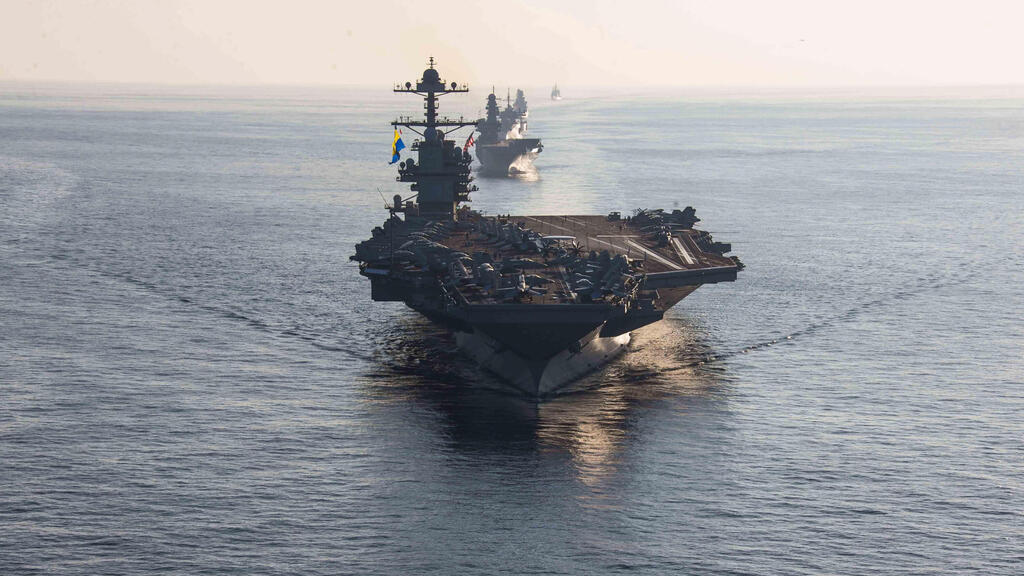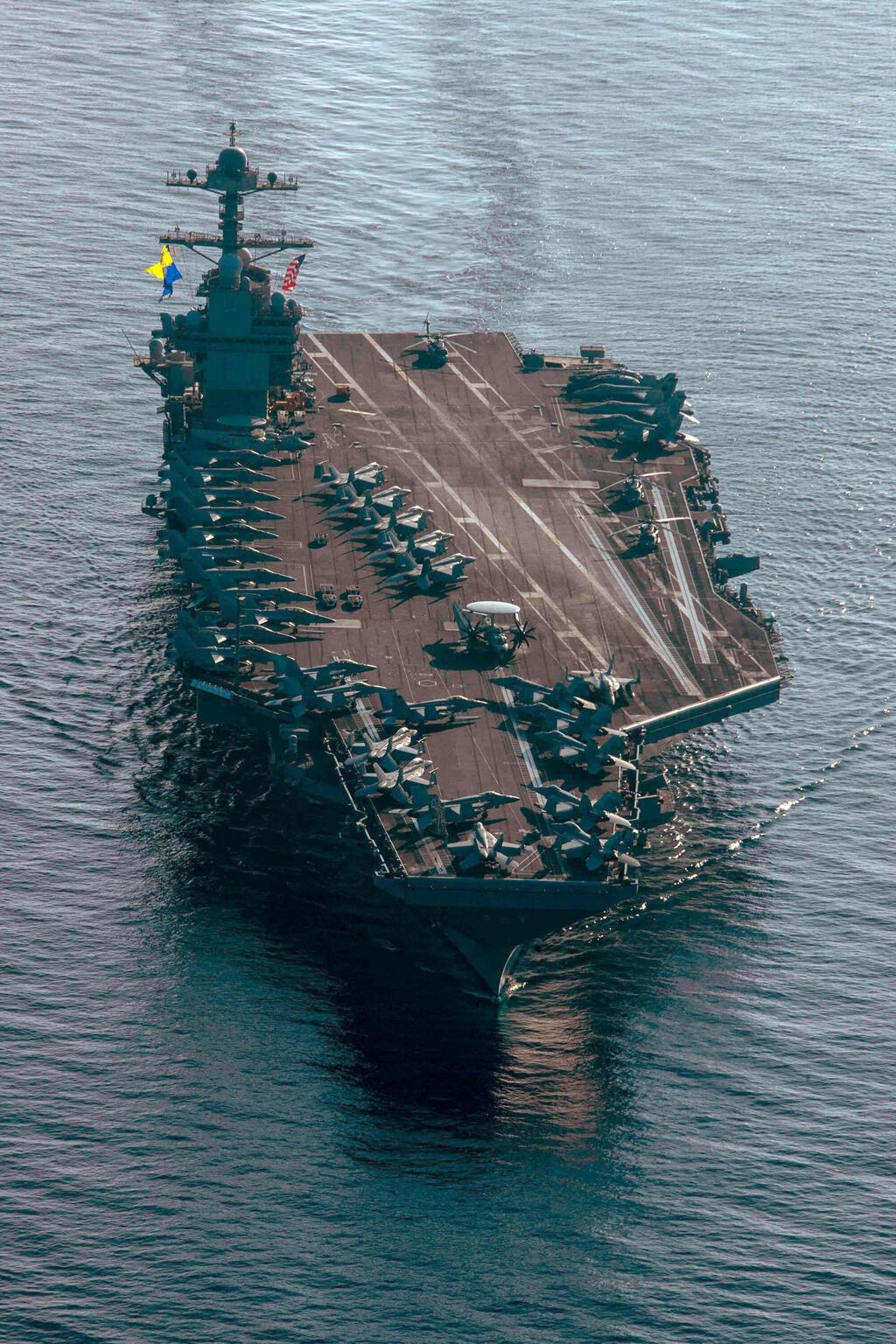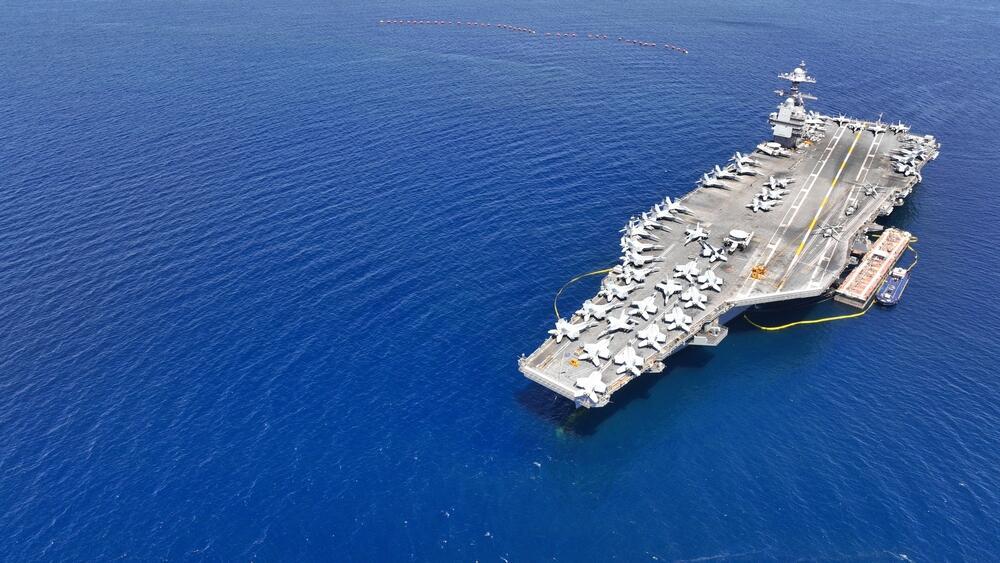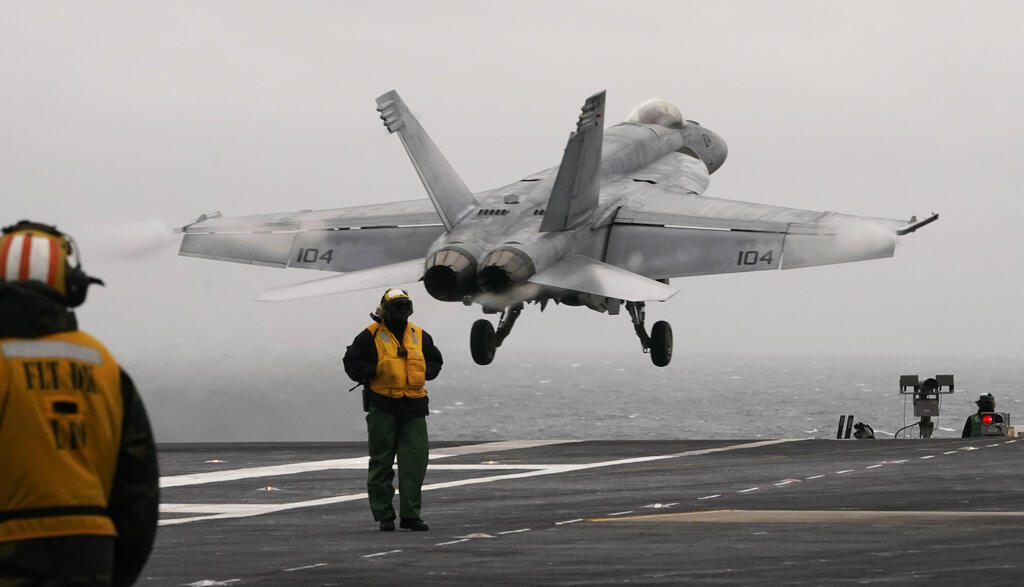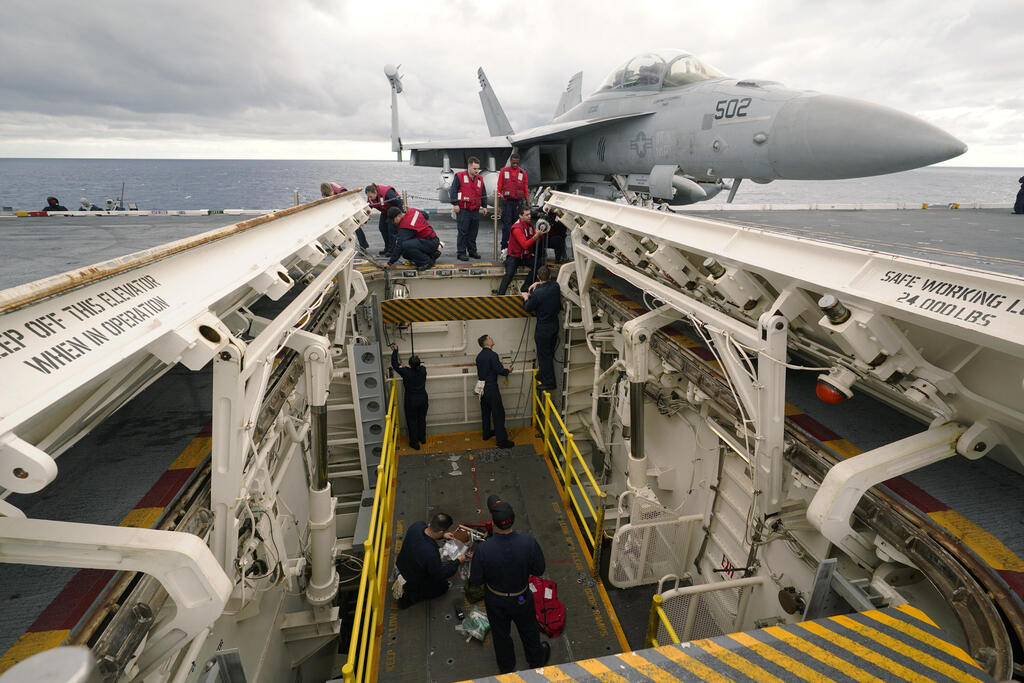Getting your Trinity Audio player ready...
In the unprecedented American support of Israel amid its war with the Hamas terror group, the navy's largest and most advanced aircraft carrier the U.S.S. Gerald Ford arrived in the eastern Mediterranean, complete with all of its 4,539 soldiers. The move serves only as a deterrent as the Americans, as National Security Council spokesman John Kirby said, have no intention of setting foot in either Israeli or PA territory or intervening in the fighting.
Read more:
The move holds practical significance for the White House, in light of the growing number of American casualties in the Hamas attack and the possible need to evacuate American citizens from the region. As well as the aircraft carrier, the Americans are also bringing the “Normandy” guided-missile cruiser closer to Israel, along with four further missile destroyers. What do we find when we unwrap this unprecedented American military gift? Could it increase in size following yesterday's announcement of plans to bring the Dwight D. Eisenhower aircraft carrier and its escort ships into the region?
USS Gerald R. Ford, named after the 38th President of the United States, is regarded as the U.S. Navy’s most advanced aircraft carrier. It holds thousands of naval personnel and carries on board over 75 F-35, F-15, and F-16 fighter jets, A-10 attack aircraft, two anti-aircraft missile launchers, two RAM surface-to-air missiles and two separate radar systems directing its missiles and aircraft and detecting enemy aircraft and missile fire. It also has onboard three phalanx weapon systems, i.e. an active cannon-based defense system to destroy missiles, rockets, and artillery fired towards her at close range, four 25 mm machine gun systems (MGS) designed to protect her from small vessels, as well as four old 0.5-inch caliber M25 Browning .5 MGSs.
Even without all this surplus weight, the USS Gerald R. Ford weighs in at 100,000 tons, spanning 78 meters (over 1000 feet) in length and 56 meters (180 feet) in width. And even at this weight, it sails at 30 km/h( 20 miles/h) (2 knots), powered by two nuclear reactors. Initially American cost estimate for building the vessel stood at $5.1 billion, but over the years this budget soared to $12.8 billion. For scale: this figure is only about $3 billion under Israel's total 2024 defense budget. And that’s without the $3 billion annual maintenance cost and the R&D ($40 billion) needed to create this marine monster.
The ship can operate independently at sea for three consecutive months in terms of food, fuel supply, and aircraft equipment. What’s needed to maintain it? Well, an entire hospital, a pharmacy, operating theaters and intensive care units, laboratories, and a fleet of dozens of paramedics medical, and officers. There are also four gyms for various muscle groups: the lower body, upper body, and chest, and one for aerobic exercise containing a boxing ring. What else is on the giant aircraft carrier? Elevators connect all ship floors, a chapel, a souvenir shop for tourists and collectors of military and memorabilia, a supermarket that looks like the Israeli dream of the American dream, a cafeteria serving four meals a day with a BBQ station, juice stand, and a 24-hour fruit and salad bar. You can enjoy Wi-Fi in various lounges and throughout the ship. There are video game monitors, billiards tables, giant TV screens broadcasting to the oceans the very best American TV shows and Hollywood movies
The second American gift, the USS Normandy, is a Ticonderoga-class guided cruiser. This term applies to warships whose order predates 1978. USS Normandy was launched in 1989 and is usually docked in Norfolk, Virginia. She was the first American warship since 1945 to go to war, crossing the Suez Canal during the Gulf War en route to the Persian Gulf. In 1998, she was awarded the title "Most Tomahawks shot by a U.S. Navy Cruiser" – one of many titles she and her crew have accrued over the years.
Holding a crew of 330 men and women, she weighs 9,800 tons and spans 173 meters (568 feet) in length, and is powered by four General Electric gas turbines, driving her to speeds of approximately 60 km/h (40 miles/h) (32.5 knots). Two Seahawk helicopters and six radar systems are permanently positioned on board, each serving different functions including fire control, air search, and underwater anti-submarine warfare. On board are also two vertical launch systems (MK 41) each holding 61 compartments containing 122 surface-to-air missiles, air warfare missiles, Tomahawks, and VLA anti-submarine missiles.
She also has eight Harpoon anti-ship radar-guided missiles, two 127 mm (5")/54 caliber (Mk 45) lightweight guns, two 25 mm MGSs, 2-4 heavy 0.5-inch caliber M25 Browning .5 MGSs, two phalanx weapon systems, and two submarine water torpedo launch systems.
The further four destroyers are all Arleigh Burke class of guided-missile destroyers named after the American World War II admiral. The cost of each is estimated at $2 billion. The youngest and largest in this group, the USS Thomas Hudner, is named after Navy pilot Thomas Hudner, who was awarded the Medal of Honor for his attempts to save the life of his wingman during the Korean War.
She took the seas in 2017 and is usually docked in Mayport, Florida, and waded into Mediterranean waters during training. She weighs 9,217 tons, is 513 meters (1683 feet) long and, like the USS Normandy, is powered by four General Electric gas turbines. She can reach 57 km/h (35 miles/h)(31 knots), carries about 380 crew members, and has one phalanx system, a Mark 45 lightweight gun, two M242 Bushmaster chain guns, and four M25 Browning .5 MGSs.
In addition to two Seahawk helicopters and a landing pad, the ship also has a vertical launching system (MK41) containing seven different types of missiles: two types of surface-to-air missiles, short and medium-range ballistic interceptor missiles, an SM-6 missile for intercepting unmanned aerial vehicles, anti-ship missiles, a vertically launched anti-submarine missile, a Tomahawk cruise missile and the evolved ESSM to counter supersonic maneuvering anti-ship missiles. There are also two triple-tube sets (Mark 32) containing three types of lightweight torpedo missiles.
Holding a similar ammunition inventory, we have the USS Roosevelt, named after the presidential couple, Eleanor and Franklin Roosevelt. She’s anchored at Naval Station Rota, a mostly American naval base on Spain's Atlantic coast. Setting sail in 1999, she boasts a long history in Mediterranean waters, including anti-pirate chases in Somalia and seizing the impostor oil tanker "Morning Glory" south of Cyprus en route to Libya. Weighing in at 9,300 tons, and holding 380 crew members and two MH-60R Seahawk helicopters, she measures 155 meters (500 feet) in length and sails at a speed of 56 km/h (35 miles/h) (30 knots).
USS Ramage, named after Vice Admiral Lawson "Red" Ramage, was decorated with the Medal of Honor during World War II. Like USS Normandy, she’s usually anchored in Norfolk and has some serious history: Taking to the waters in 1995, she took part in various operations including in Albania in 1997 and off the coast of Montenegro two years later.
Following 9/11, she was commissioned to of the American East Coast to provide expanded radar to New York City and the surrounding area following the terrorist attacks. She then set sail to the Arabian Sea for the Afghan War. She carried on to fight Somali maritime terrorism and pirates around the Horn of Africa. In 2010, she was sent to assist in search and rescue efforts following the crash of an Ethiopian Airlines plane in the Mediterranean. She even docked for a time in Haifa Port. After returning to her mother port, she came back to the Mediterranean during the Syrian Civil War to act as a threat to Bashar al-Assad amid accusations of his use of chemical weapons in the Damascus suburbs. She also numbers among the ships operating in the Mediterranean during the 2014 Sochi Winter Olympics. This year it was decided to extend the ship’s life until at least 2035.
Holding a crew of 280 and weighing 900 tons, the USS Ramage is similar to her younger sister ships – but there’s just one Seahawk helicopter parked on her deck. In terms of rifle and missile ammunition, she’s quite comparable to her sisters but has the cutting edge of electronic warfare designed to disrupt anti-ship missiles at great distances from their targets.
The ship holds "electronic warfare suites" including elements operated with infrared disruptors designed to lure enemy radars, which include simulated ship noise, simulated flying bait, and reflective buoys. She also has extremely impressive radar systems including a computerized search radar utilizing four complementary antennas providing 360° aerial coverage. She also has a further ten different radar systems for surface search and navigation, mine avoidance, electro-optical optical vision, fire control, and anti-submarine warfare using sonar and helicopters.
The oldest of the four, USS Carney, is named after Admiral Robert Carney, who served as Commander-in-Chief of the U.S. Navy during the Eisenhower administration. Originally from Mayport, Florida, she was launched in 1994 and also took part in the Afghan War and docked for a time in Bahrain. After fleeing Hurricane Charlie in 2004, she was happily received as guest of honor when she was sent to the Caribbean to express the United States' commitment to her regional partners. She fought ISIS in Libya, in 2018, and was caught up in the tensions between Russia and the United States following the US announcement of indictments against Russian citizens on suspicion of interference in the 2016 US election campaign.
Her scale and ammunition are similar to that of USS Ramage, but she boasts a number of unique elements and even more radar systems – albeit neither more innovative nor sophisticated. The USS Carney, for example, has the small, lightweight SeaRAM (CIWS) Rolling Airframe surface-to-air missile that uses infrared and rolls as it flies.



